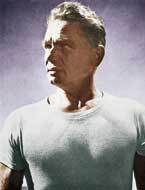Get ready to rock and roll! Rolling movements in Pilates are meant to rid the body of toxins and massage the spine. This one requires more coordination and balance compare to Rolling like a Ball. Have fun!
 |
4A Starting position 4B Movement while rocking
|
Purpose- Massage the spine, rid the body of toxins, open hips, coordination w/clapping, balance
Preps- Cat/Cow, Rolling like a Ball, Pre-Roll Up, Bridging
Form- Do not roll onto head or neck, hollow abdominals, stay in compact ball shape (keep the same distance of heels to bottom)
*Not appropriate for someone that isn't able to flex spine well (osteoporosis, disc injuries, fusion) or those who aren't supposed to be inverted (glaucoma, high blood pressure, pregnancy)
Modifications- Roll keeping heels together (no clapping/barking), Half Roll Backs
How to Advance- 1-3 claps w/heels on back and when balancing at the top
Challenges- Seal into standing position by crossing feet on floor








